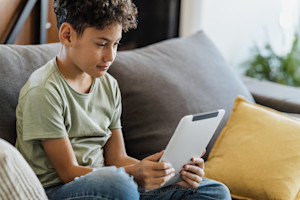Kids on social media: 3 benefits, 3 risks

Amanda Lee
Senior Program Manager, Tech for Good™ & TELUS Wise®

The vast majority of Canadian youth are using social media daily. According to Media Technology Monitor’s MTM Jr. report, which researches media habits of youth from seven to 17 years old, seven in 10 children use social media, with half of seven- to 11-year-olds and 85% of teens using social media in the past month. Social platforms help them connect, develop digital skills, and express themselves. However, along with the benefits come risks. Parents, caregivers and educators can help create a safe online environment by being aware of both the advantages and challenges of social media.
What’s great about it?
There are a lot of benefits of social media for kids. Let’s focus on three.
#1: It’s social
Kids can connect beyond their immediate physical worlds of family, school and hobbies. They can seek out communities based on shared interests, whether they are music, sports, culture or causes. And within those communities, they can establish real friendships with people living in different places with different perspectives and worldviews. Social media also provides a great forum to join and participate in support networks. For instance, 2SLGBTQIA+ youth and kids from different cultural backgrounds can connect with people that share their experiences, access resources and find opportunities to further engage with the communities they belong to online and offline.
#2: It promotes digital literacy
Kids today are known as “digital natives”. They are growing up with technology and don’t know any differently. Social media can teach vital communication and technical skills that are part of both life and career training. Interacting face-to-face in our physical world is part of social development, but interacting online is also a vital element of learning how to relate, set boundaries and participate responsibly in relationships and communities.
#3: It gives kids a voice
There are so many inspiring stories of how kids have used social media to spark their own passions for social issues, raise awareness and effect change. Neb, a recipient of the TELUS Student Bursary, is a great example. He is the founder of Brothers4Brothers, a youth-led mentorship program aimed at combating stigma and promoting awareness of men's mental health and is also the driving force behind Community Cares, an initiative that provides care packages filled with essential items to underprivileged youth. As an artist, motivational speaker, content creator, social justice advocate, podcast host, youth ambassador, and mentor, Neb leverages social media to connect with others and advance his work. Whether it’s anti-cyberbullying events, fundraisers or marches that call attention to social issues, kids are turning to social media to promote social responsibility, community service and global awareness. In fact, Common Sense Media, a leading source of entertainment and technology recommendations for families and schools, lists 21 websites catering to kids aged eight to 16 that help them do good.
What are the risks?
Benefits also come with risks. While there are a lot of great things about social media, there are some risks too. Let’s focus on three.
#1: Incessant marketing
Many companies spend a lot of time and money figuring out how to best market to the coveted youth demographic. And social media is fertile ground for advertisers and marketers. There are regular ads, which are easy to spot. But sponsored and influencer content is more covert. The bottom line? Kids are being marketed to almost constantly on social media and advertisements like this have the ability to impact a child’s values, beliefs, self confidence and more.
#2: Cyberbullying
With so much socializing taking place on social media, there is a lot going on “behind the screen” that parents can’t see. And if kids aren’t sharing their experiences, parents often never know the frequency or severity of online bullying until the damage is done. Common forms of cyberbullying include verbal/emotional abuse, social exclusion, gossip and publicizing content that was meant to be private. Emotional consequences can include isolation, anxiety, depression and in extreme cases, even the tragic loss of life. There can also be legal consequences as we explored in our article, “Cyberbullying can be criminal.”
#3: Unrealistic expectations and mental health
There is most certainly a filtered reality on social media. Influencers and celebrities have full teams behind them to help capture and post the perfect selfie (this great video from Dove’s Self-Esteem project casts a critical eye on what really goes into that casual selfie you may see online). The unrealistic beauty standards flooding social can be damaging to kids who are just forming their own identities and relationships with their bodies. According to the Dove Global Beauty and Confidence Report, 6 in 10 (65%) girls believe that media and advertising set an unrealistic standard of beauty most women can’t achieve. The Hospital for Sick Children in Toronto also found that social media and smartphone use increase the burden of mental distress. The Hospital has seen admissions for mental health reasons increasing, and suicide has become the second most common cause of death for Canadian youth.
3 things you can do
If you’re encouraged by the benefits of social media but are concerned about the risks, there are things you can do with your kids to mitigate them.
#1: Start responsible social media use early
Modeling responsible behaviour on social can help your kids understand what is and isn’t acceptable behaviour. And if you start having these conversations early, you’ll help your kids form healthy habits that will follow them throughout their digital lives.
#2: Set boundaries
Create rules for social media together and decide on the appropriate consequences if they aren’t followed. By involving kids in the process, they understand your concerns and have contributed to their own boundaries online.
#3: Have honest conversations
Dove’s #NoLikesNeeded campaign teaches kids that the only “like” that counts is their own. Campaigns like this are great conversation starters about what we see online and how it makes us feel. Explain the importance of having a critical eye and healthy scepticism on social media. View the unrealistic images together and talk about how they are created and why. Talk about AI influencers who aren’t even real and strategies for how to spot them! And then find positive role models who are not only real humans, but are revered for their strength, intelligence or abilities rather than just looks and/or entertaining content.
Social media can be a productive, inspiring and empowering place for kids. With limits, digital literacy and ongoing conversations, it is easy to find the balance between the benefits and the risks. For more tips on how to help your kids navigate our digital world, take the TELUS Wiseᵀᴹ parent workshop online. You can also encourage your child to complete the TELUS Wiseᵀᴹ happiness workshop. Or better yet, do it together! Visit telus.com/WiseWorkshops.
There is more to explore

Social media
Do you know what your kids are watching on YouTube?
Learn how to keep your kids safe on YouTube with built-in parental controls, supervised experiences and practical conversation tips.
Read article
Social media
When kids become content: the risks of sharenting
Learn how to share responsibly and respect your child’s privacy, right to consent and digital future.
Read article